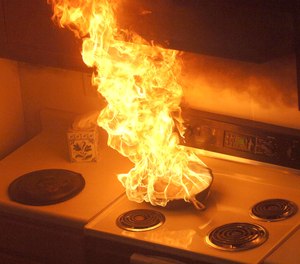How to put out a kitchen fire
Courtesy of FireRescue1 by Lexipol
A generous thank you to Plano Fire Department Capt. Peggy Harrell for her contribution to this article.
By Shelbie Watts, FireRescue1 Editorial Assistant
The holidays are upon us, which means turkey, ham, stuffing and kitchen fires – a lot of kitchen fires. In fact, there are so many dinner disasters that Thanksgiving and Christmas are the peak days for home cooking blazes, according to the NFPA.
In an effort to keep your community safe, Plano Fire Department Capt. Peggy Harrell provided some tips on what residents should (and shouldn’t) do to prevent bad information and “fight or flight” instincts from creating a serious problem.
MICROWAVE AND OVEN FIRES
You can handle flames that erupt in your microwave or oven in three easy steps:
- Keep the door closed.

- Turn off the appliance (unplug it if you can).
- Let the fire burn out in the enclosed space.
Remember, no peeking!
“The fire went out because it ate up all the oxygen in the space, so we don’t want to open the door and feed it any more oxygen,” Harrell said.
STOVETOP FIRES
According to Harrell, “just a little thought and action before you turn the heat on” can prevent a stovetop disaster.
“When you’re selecting the pot or pan you’ll be using to cook on your stovetop, also pull out the lid to the pot or pan, or a cookie sheet that is large enough to completely cover the pot or pan,” she said.
If a fire starts, grab the lid or cookie sheet that you have handy and cover up the flames until they smother out.
Again, no peeking!
OIL OR GREASE FIRES
Harrell said residents often experience an “adrenaline dump” when a kitchen fire occurs, and an oil or grease fire mixed with that adrenaline can cause problems if you try and move your pan or pot to the sink or outside. Your best bet is to not even try it, and instead:
- Cover the flames with a metal lid or cookie sheet. Leave the cover on until it has cooled.
- Turn off the heat source.
- If it’s small and manageable, pour baking soda or salt on it to smother the flames.
- As a last resort, spray the fire with a Class B dry chemical fire extinguisher.
KNOW WHEN TO CALL FOR HELP
“If a fire does occur while cooking, fighting it may not be the best plan of action,” Harrell said.
Ask yourself these questions to determine if you need to call 911:
- How large is the initial fire?
- How fast is the fire growing?
- What is feeding the fire?
- Will anything in the proximity of the fire feed it?
- Is anyone in the home that depends on you to evacuate?
“If any of these factors are in play and make the extinguishing part of the fire unrealistic or dangerous, just move quickly to call 911, alert others to get out, and assist those who need your help out,” Harrell said.
